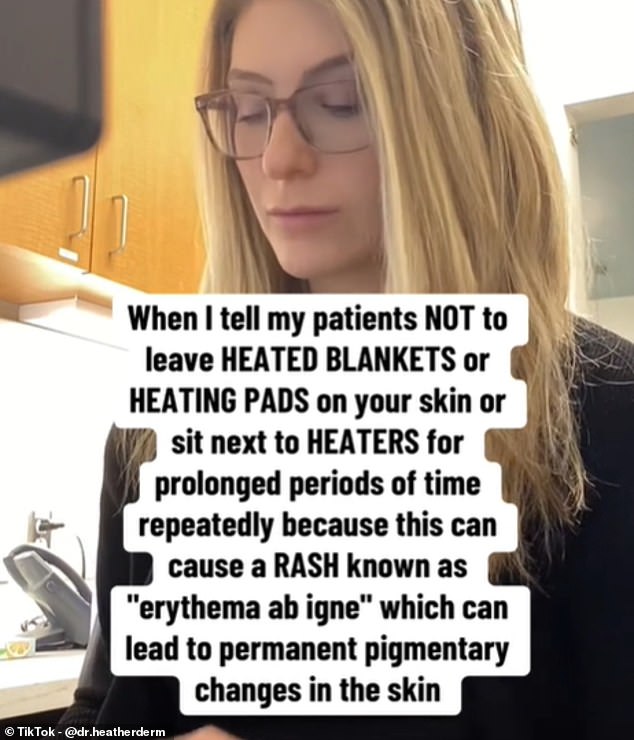As cold weather arrives, many people turn to heated blankets for comfort and warmth.
However, a doctor is warning of how a wintertime staple can lead to permanent skin damage.
Dr Heather Kornmehl, a Texas-based dermatologist, told her 106,000 followers in a TikTok that heated blankets can cause an irreversible rash known as erythema ab igne (derived from Latin and translated as ‘redness from fire’).
Caused by the long-term use of heat directly against the skin, it leads to a red or brown rash with a distinct net-like pattern in appearance, as well as itchiness.
It can happen to anyone who is exposed to chronic low-level heat, such as a heated blanket, but also from using a hot water bottle, resting a laptop on your legs or leaning against a radiator.
The heat is usually not enough to cause a burn, but it is enough to damage or cause changes to superficial blood vessels under the skin, as well as the collagen and elastin protein fibers of the skin, which leads to the distinct appearance and discoloration.
This skin rash is usually permanent, and can leave you marked for life.


In her TikTok, which has been viewed more than 2.6million times, Dr Kornmehl also warns against using heating pads directly on your skin or sitting next to heaters for ‘prolonged periods of time repeatedly.’
She adds in the caption: ‘With the cold weather coming our way, we need to be careful about repeatedly applying prolonged heat to our skin.’
The NIH says erythema ab igne was historically a condition found in bakers and industrial workers who were exposed to heat for long periods of time.
But this condition has ‘recently resurfaced in medical literature with the use of novel heat sources such as laptops and heated car seats.’
The experts note while the condition can be remedied by the removal of heat exposure, if there is a delay in diagnosis or the heat exposure continues, it can lead to permanent pigmentation.
More worryingly, it can progress to various forms of skin cancer.
The condition – which is also referred to as toasted skin syndrome – is known to be more prevalent in women than men and patients with chronic pain.
Most people have no associated symptoms, but some can experience itching, burning, or tingling pain.
Dr Ji Qi, a dermatologist in Baltimore, Maryland, says the best way of preventing erythema ab igne is to stop using the external heat source directly on your body and use something as a buffer.
She advises: ‘If you use a laptop, put it on a table or desk instead of your skin.
‘If you must put it on your lap, use a lap desk as a buffer between the laptop and your skin.

‘If you use a heating pad or electric blanket, use the lowest possible setting and or limit duration of use.’
Dr Qi says a major cue to immediately remove the heat source is reddening skin.
In milder cases of toasted skin syndrome, Dr Qi notes that the skin changes usually fade, though it may take several months or longer.
However, in more severe cases, the skin changes can be permanent.
Laser therapy and depigmenting creams could be used to help treat the pigmentation.
A paper in the Cleveland Clinic Journal of Medicine looks at one severe case of erythema ab igne.
A 42-year-old man told how he had been consistently using a heating pad for ‘several hours at a time’ to deal with chronic back pain linked to his labor intensive job.
Upon a physical examination, doctors discovered a large, hyperpigmented, dark brown, mottled patch spread over his back.
The man said it was not painful or itchy and he confirmed the area of hyperpigmentation corresponded to the area of heating pad use.
Given this history and the physical findings, a diagnosis of erythema ab igne was made.
The paper’s authors note the condition is ‘uncommon’ and hot water bottles and heating pads are most often the culprits.
